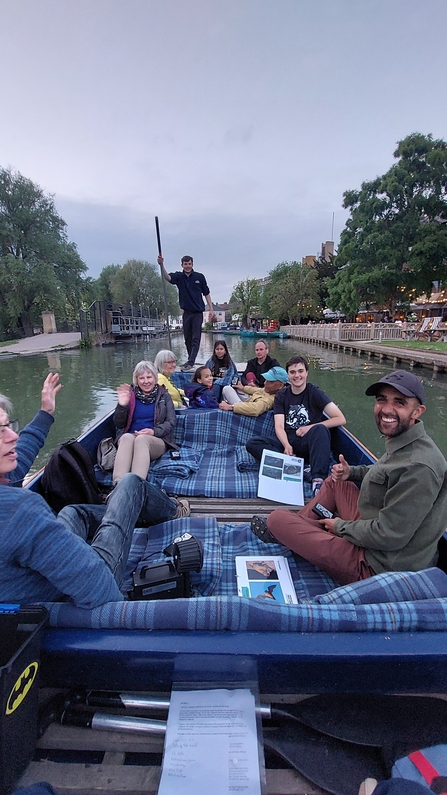
At the beginning of May, the Wildlife Trust BCN ran their first bat punt safari of the season in Cambridge. As it was the maiden voyage of 2025, the punt was loaded up with WT staff, science communicators Ajay Tegala and Maya-Rose Craig and new president of Wildlife Trust BCN, Sir Partha Dasgupta. I took up the last spot as a representative from the Trust’s Young People’s Forum.
Setting off on the river after eight o’clock, the sun was still at the early stage of setting. We departed from the spot just across the river where I had seen my first bat of the year a few weeks before - an auspicious start to the safari! A Scudamore punter skillfully steered us down the river towards Grantchester while Nik Shelton from the Wildlife Trust was our knowledgeable guide to the bats of the River Cam.
On the first stretch of the river, dusk hadn’t quite descended and the bats weren’t appearing just yet. Crows were cawing assertively at us from their high perches on the trees lining the river bank. Swans and ducks sailed past the punt. One mallard had a long trail of fluffy ducklings following her downstream. A heron’s nest was precariously positioned on top of some exposed tree branches and an ungainly chick flapped lopsidedly beside it in the air, seemingly defying gravity.
Only a small time had passed when the first chirps of the bats’ echolocation calls could be heard through the bat detectors that each of us had been given for the safari. Bat detectors are small devices that translate the ultrasonic calls of bats into frequencies in the human range of hearing which is limited at about 20kHz. I had the frequency set at 50kHz so the sounds emanating from the one I was using were probably from Pipistrelle and Daubenton’s bats. 12 of the 18 UK bat species can be found in Cambridgeshire but these were the most likely candidates, both with a calling frequency at approximately 45kHz. Soprano and Common pipistrelle bats are the most common UK bat species and Daubenton’s bats hunt along water bodies, using their tail membranes as a scoop to shovel insects into their mouths.
Nik narrated facts about bats to us while we gazed up at the fast black shapes flitting across the river, swooping and diving above the punt as clicks and chirrups radiated from the bat detectors.
The ultrasonic calls that bat detectors pick up are used by bats to navigate and hunt in a process called echolocation. Not all bats echolocate, but those that hunt insects often do so that they can catch their prey in the dark. The sound waves bats produce bounce off of objects in its environment and the time for the echo to return allows the bat to form a map of its surroundings since the longer away an object is, the more time will pass before the call bounces back. A higher frequency of calls creates a more detailed map because if more echoes are bouncing back, more information can be ascertained about the environment. High frequencies are needed for hunting, for example, so that small insects can be targeted. Bats even take into account the Doppler Shift which is where sound frequencies change depending on if the object is moving towards or away from the bat. This enables the bat to know which direction its prey is moving in. The invention of bat detectors has been important for understanding how bats communicate and ‘see’ the world in the dark.
Although it had been a beautiful day with beaming sunshine, a chill soon set in as the sun vanished below the horizon. It was at this point that I regretted not bringing a coat. By the time we arrived at Grantchester, the light had all but disappeared. The moon was out but wisps of clouds obscured it occasionally. A large torch had to be turned on at the front of the boat so that we could see our way back and its sweeping beam illuminated bats starkly against the night sky. All was silent apart from lapping water and animal calls that travelled far on the river and across the flat landscape beyond. In the distance, the lights of Cambridge drew us back down the Cam. It was a peaceful journey back but a spooky atmosphere certainly settled over us for the remainder of the trip!
Bats are a crucial indicator species for biodiversity and are unique and fascinating creatures. The bat punt safari was an amazing experience to see them at close-quarters from a perspective you don’t usually get to see them at!
Find out more about the Bat Punt Safaris and book at www.wildlifebcn.org/bat-punts

